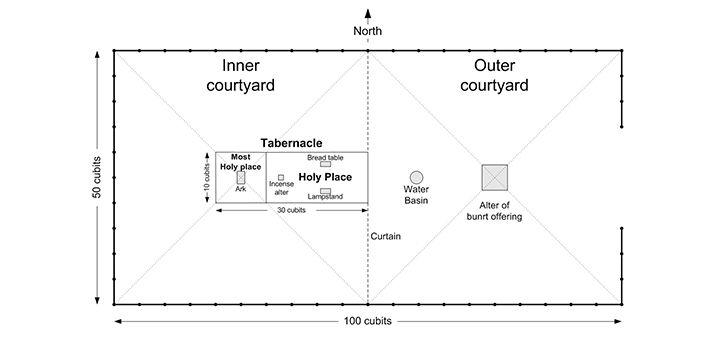“Then shall the sanctuary be cleansed.”
It would be difficult to imagine any phrase in the Bible that has spilled more ink among Adventists than that phrase from Daniel 8:14. Although a great deal of effort has been directed at the word “then,” that is not one of the words I’m going to concentrate on at this time. Instead, I intend to look at the words “sanctuary,” and “cleansed.”
For what it is worth, I do not contest the October 22, 1844 date. I also do not think the precise date matters that much. But that is for another post.
There are, of course, numerous interpretations of these two words. Instead of “the sanctuary be cleansed,” the NASB has “the holy place shall be properly restored.” And there are others. Scholars are not of one accord about what the meaning of this phrase. I do not claim to be a scholar, so whatever I say here will not “settle” the issue. That is not my intent anyway.
What I hope to do is to suggest a plausible understanding of this verse.
I propose that we examine each of the two words in turn. First, what is meant by “sanctuary?” As already noted, this can also be translated “holy place.” In our history, it has been common to focus on The Day of Atonement, and with good reason. The Day of Atonement was, and is, seen by Jews as a foreshadowing of the final eradication of sin. The Day of Atonement is, as most readers will already know, the only time during the year when anyone entered the most holy place. And on that day, only the high priest went past the veil that separated the inner and outer portions of the tablet or temple. On every other day, the blood of the daily sacrifices, and the high priest bearing that blood, stopped at the altar of incense just before the veil. So great deal of attention has been paid to the altar of incense. Perhaps that is the right emphasis. But I will propose an alternative.
At the top of this post you will see a diagram of the sanctuary encampment. Most Adventists will be familiar with this. When God said to Moses, “Let them make me a sanctuary, that I may dwell among them,” in Exodus 25, he then gave the plans for this entire complex. The Sanctuary, then, refers to this plan in its totality.
At its inauguration, the Pillar of Cloud/Fire hovered over the Most Holy Place, and the Shekinah illuminated that part of the Sanctuary, both signifying God’s Presence.
As you know, this served as a sort of diagram of the plan of salvation. A penitent would approach from the East, where the only opening to the tabernacle courts was located. He would bring a Lamb or other offering, which he would sacrifice there. A priest would take the sacrifice to the Brazen Altar of Burnt Offering, for only the priests and Levites were allowed within that space.
The blood from the sacrifice would be poured out at the foot of the altar, most of the carcass would be roasted or burned there. The priest would then take some of the blood from the sacrifice, and combine it with incense. After ceremonially cleansing himself at the Laver, he would then cross into the heavenly half of the courtyard, into the tabernacle itself, and place the incense at the Golden Altar of Incense.
The smoke of the incense would ascend over the veil separating the Holy Place from the Most Holy Place.

This process foreshadowed and illustrated the plan of salvation. The sinner comes to God, and offers the blood of the Lamb of God. But as we are a nation of kings and priests, we come to the Cross, which is what the Altar of Burnt Offering prefigured. Having accepted Christ’s sacrifice on our behalf, we then proceed to baptism, which is clearly indicated by the Laver. Then we can “boldly approach the throne of grace,” and symbolically come to the Altar of Incense, where our prayers ascend to the throne, symbolized by the Ark of the Covenant.
Not only does this a sanctuary illustrate the sinner’s path to salvation, it also illustrates the path Christ took in the Incarnation. We just said that the sinner accepts the blood of the sacrifice at the cross — the Altar of Burnt Offering — and then moves on to baptism, at the Laver, and from there to the throne of grace.

But Christ came from the Throne, in heaven, to this Earth. In the Sanctuary plan/diagram, that would be moving from the Ark of the Covenant, into the earthly half of the courtyard, and then to the Cross, as symbolized by the Altar of Burnt Offering. But the Laver is in between. Meaning that in this symbolic journey, Jesus would have to be baptized before he went to the Cross, which is exactly what he did!
There is actually much more we can say about this, but that will suffice for our purposes now. I believe you can now see that when I say the Sanctuary was a diagram or illustration of the whole plan of salvation, that’s exactly what I mean, and that’s exactly what it is.
The Sanctuary is, then, more than the sum of its parts. The Sanctuary is not just the Altar of Incense, nor is it just the Altar of Burnt Offering, or just the Ark of the Covenant. It is all of those elements, and more importantly, I believe, what they symbolize. I believe that in the passage we began with, in Daniel 8:14, “sanctuary” means God’s plan for saving humankind.
Next time, I will take up the second word: “cleansed.”








